Why this resume works
- Quantifies accomplishments: By showcasing metrics like a 40% enhancement in reporting processes, the applicant’s quantified achievements show their strong contributions.
- Showcases career progression: The applicant’s rise from data strategist to data analyst reveals a journey of increasing responsibilities and expertise, highlighting impressive career progression over time.
- Highlights industry-specific skills: Skills such as SQL querying and dashboard creation highlight the applicant’s alignment with industry demands, emphasizing their readiness for roles requiring advanced data handling abilities.
More Data Analyst Resume Examples
Take a look at our data analyst resume examples to learn how to highlight your analytical skills, technical tools, and experience. These statistics resume samples will help you build a resume that stands out to employers.
Entry-Level Data Analyst
Why this resume works
- Centers on academic background: The applicant’s education section showcases a solid foundation in data science and statistics, emphasizing significant academic achievements important for early career development.
- Effective use of keywords: Incorporating essential keywords such as “data analysis,” “SQL,” and “machine learning” reflects an understanding of applicant tracking systems (ATS) requirements for data-driven roles.
- Shows digital literacy: Skill in tools like Python and SQL illustrates the applicant’s computer skills, highlighting readiness for tech-centric environments.
Mid-Level Data Analyst
Why this resume works
- Points to measurable outcomes: Transforming data processes that led to increased sales and reduced costs, the applicant emphasizes their ability to achieve measurable outcomes effectively.
- Demonstrates language abilities: Knowledge in Spanish, German, and Mandarin, the applicant’s language skills improve cross-cultural communication within diverse teams.
- Displays technical expertise: Possessing certifications like Tableau Expert and advanced SQL, the applicant showcases a strong grasp of technical skills important for data analysis roles.
Experienced Data Analyst
Why this resume works
- Showcases impressive accomplishments: Highlighting accomplishments like boosting revenue by 15% and reducing costs by 25%, the applicant reflects exceptional senior-level performance.
- Sections are well-organized: Using bullet points for each role clearly presents key responsibilities, making work experience easy to scan and the resume reader-friendly.
- Emphasizes leadership skills: Leading a team in successful data migration showcases significant leadership skills, emphasizing the applicant’s ability to manage projects effectively.
Data Analyst Resume Template (Text Version)
Aya Wang
Riverside, CA 92516
(555)555-5555
Aya.Wang@example.com
Professional Summary
Expert data analyst with mastery in visualization and predictive analytics. Excel at SQL, boosting operational efficiency. Proven track record in achieving high-impact results.
Work History
Data Analyst
Data Insights Holdings – Riverside, CA
May 2023 – August 2025
- Enhanced reporting processes by 40%
- Conducted analytical reviews improving data accuracy
- Implemented dashboards leading to 30% efficiency
Business Intelligence Specialist
Precision Data Labs – Los Angeles, CA
March 2021 – April 2023
- Developed KPIs boosting sales by $1.5M
- Optimized data models enhancing forecasts
- Managed SQL databases increasing performance 25%
Data Strategist
Tech Solutions Network – Los Angeles, CA
August 2019 – February 2021
- Led project yielding 15% cost savings
- Crafted analyses boosting profit margins
- Adapted strategies increasing ROI by 10%
Languages
- Spanish – Beginner (A1)
- German – Beginner (A1)
- French – Intermediate (B1)
Skills
- Data visualization
- Statistical modeling
- SQL querying
- Advanced Excel
- Machine learning
- Predictive analytics
- Data mining
- Dashboard creation
Certifications
- Certified Data Analyst – Data Certified Institute
- Python for Data Science – Code Academy
Education
Master’s Data Science
Stanford University Stanford, CA
June 2019
Bachelor’s Statistics
University of California, Berkeley Berkeley, CA
June 2017
Related Resume Guides
Advice for Writing Your Data Analyst Resume
Delve into our expert advice on how to write a resume tailored for aspiring data analysts, ensuring you effectively showcase your expertise in data manipulation, statistical analysis, and problem-solving.
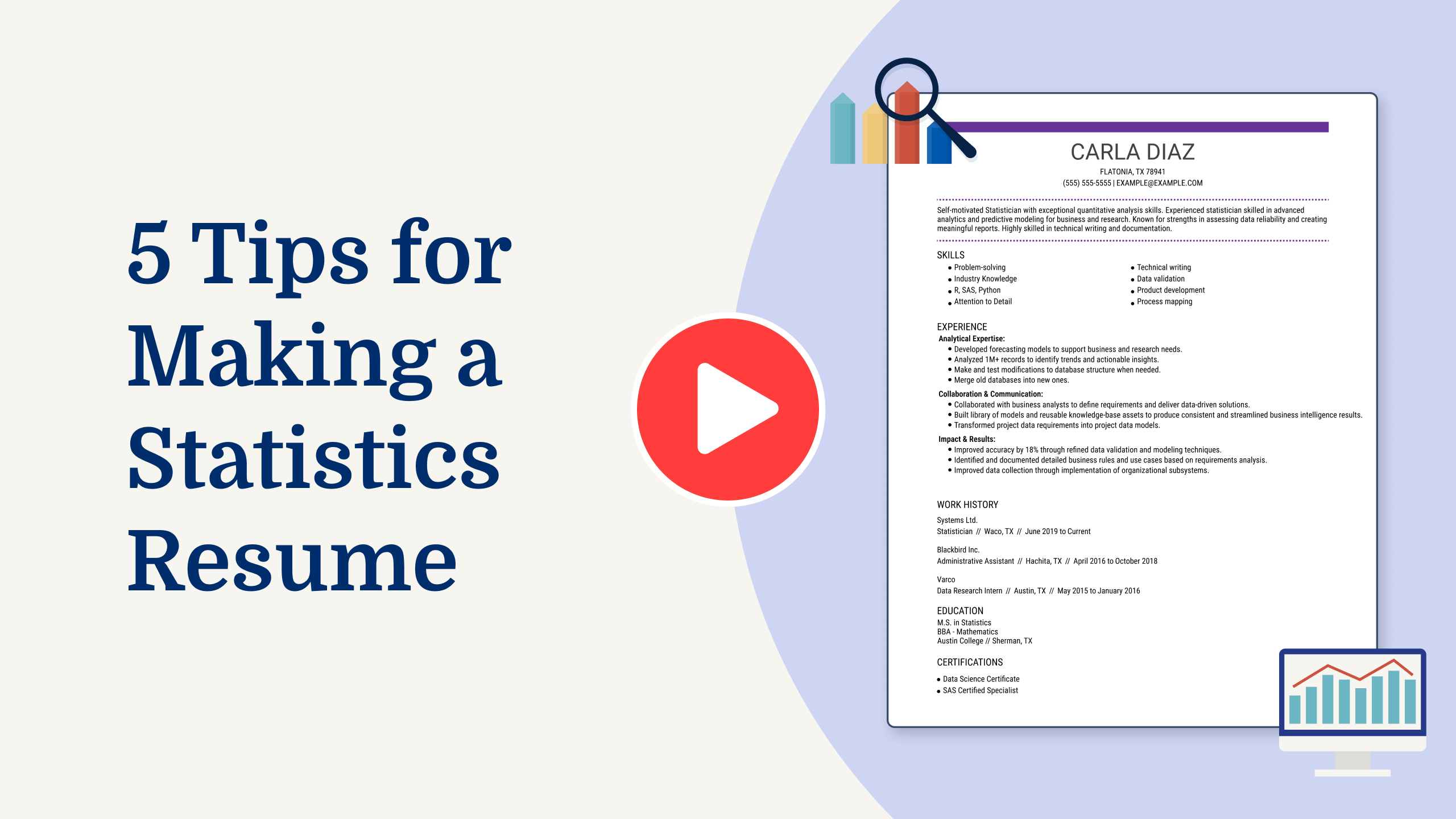
Highlight relevant technical skills
Technical skills are a key part of being a data analyst, as they form the foundation for working with data effectively. To showcase your abilities, create a technical skills section in your resume that lists tools, programming languages, and software you know well.
For example, include skills like SQL for querying databases, Python or R for data analysis and visualization, and Excel for handling spreadsheets. If you’ve worked with specific tools like Tableau or Power BI to create dashboards or used statistical methods to interpret data sets, make sure to highlight them in this section.
You can also integrate these abilities into your work experience by describing how you’ve applied them in past roles. For instance, mention optimizing database queries to improve processing time or cleaning and analyzing large datasets to assist decision-making processes. Employers prioritize practical examples of how these tools have been used in real-world settings.
Some common technical skills for this role include knowledge of relational databases, scripting languages such as Python or R, data visualization tools like Tableau or Power BI, advanced Excel functions (e.g., pivot tables and macros), and familiarity with cloud platforms like AWS or Google Cloud. Tailor your list carefully based on the job description and focus on the skills most relevant to the position you’re pursuing.
Example of a technical skills section
- Data analysis tools (Excel, SQL)
- Statistical software (R, Python)
- Data visualization (Tableau, Power BI)
- Database management systems (MySQL, PostgreSQL)
- Machine learning algorithms
- ETL processes
- Big data technologies (Hadoop, Spark)
Employers look for more than just technical skills. Use our Resume Builder to highlight your teamwork and communication abilities to show you work well with others.
Quantify your accomplishments
Quantifying accomplishments on a resume makes it stand out because it shows exactly what you’ve achieved in your role, rather than just listing duties. For a data analyst, this means turning tasks into achievements with numbers and results.
In the work experience section, start with your job title, employer name, location, and employment dates. Then focus on how you made a difference by using measurable outcomes like percentages, time savings, cost reductions, or efficiency improvements. This approach helps tell your story in a clear and powerful way.
Using action verbs combined with metrics gives your resume a results-driven edge. Instead of saying “responsible for analyzing data,” say “improved data processing speed by 30%,” or “reduced reporting errors by 15%.” This tells hiring managers exactly how you impacted the company and reveals your skills at a glance.
Quantified accomplishments make it easy for them to see your value quickly and understand the scope of your abilities as a data analyst. By focusing on these concrete achievements, you’ll create a compelling resume that highlights your success in past roles.
5 data analyst work history bullet points
- Analyzed complex datasets to identify trends, improving business decision-making and increasing revenue by 15%.
- Developed automated data visualization dashboards, reducing report generation time by 40%.
- Collaborated with cross-functional teams to refine data collection processes, improving data accuracy by 25%.
- Implemented statistical models to forecast sales performance, achieving a 20% increase in prediction reliability.
- Conducted A/B testing for marketing campaigns, optimizing strategies and boosting customer engagement by 10%.
Need help making your resume stand out? Check out our professional resume examples to see how to highlight your skills the best way.
Write a powerful professional summary
A professional summary on a resume serves as an introduction to hiring managers, giving them a snapshot of your skills and achievements.
A professional summary is a short paragraph that highlights your experience, key skills, and notable achievements. It’s best for those who have been in their field for a while and want to showcase their professional identity and the value they bring. A strong professional summary can help you stand out by quickly showing what you’ve accomplished.
In contrast, resume objectives are brief statements outlining your career goals. They are ideal for entry-level job seekers, career changers, or those with employment gaps. While summaries focus on “what I’ve accomplished,” objectives emphasize “what I aim to contribute.”
Next, we’ll provide examples of both summaries and objectives tailored for different industries and levels of experience.
Data analyst resume summary examples
Entry-level
Recent graduate with a Bachelor of Science in data science and certified in Tableau. Experienced in data visualization, statistical analysis, and SQL through academic projects and internships. Eager to leverage foundational skills to support data-driven decision-making processes in fast-paced environments.
Mid-career
Data analyst with over five years of experience in the finance industry, specializing in predictive analytics and trend analysis. Proven track record of improving business operations through data insights and advanced Excel modeling. Known for strong problem-solving abilities and effective collaboration with cross-functional teams to drive strategic initiatives.
Experienced
Seasoned data analyst with a decade of expertise in machine learning models and big data technologies within the healthcare sector. Demonstrated leadership in managing projects that improve patient care through predictive analytics solutions. Holds a master’s degree in data analytics and is committed to mentoring emerging professionals while driving innovation.
Data analyst resume objective examples
Recent graduate
Detail-oriented recent graduate with a Bachelor of Science in data science, seeking an entry-level data analyst role to apply strong analytical and problem-solving skills. Passionate about leveraging statistical knowledge and skill in Python to extract insights and drive decision-making processes.
Career changer
Driven marketing professional transitioning into data analysis, equipped with a robust understanding of consumer behavior and data interpretation. Eager to contribute analytical skills and Excel expertise to uncover trends and support strategic planning in a collaborative team environment.
Entry-level applicant with certification
Certified data analyst with hands-on training in SQL and Tableau, seeking to join an innovative company as an entry-level data analyst. Committed to using data visualization techniques to transform complex datasets into actionable business intelligence.
Using a clear resume template helps employers focus on your skills. Opt for layouts with clean lines and easy-to-read fonts, avoiding flashy graphics that obscure important details.
Showcase your credentials
In the field of data analysis, having certifications can really help you stand out. They show you have specific skills and knowledge that are important for the job. Certifications are like proof that you know what you’re doing with data tools and systems.
By listing them in a separate certifications section on your resume, you make it easy for employers to see this right away. It’s a good idea to put this section near your education so they can see all your qualifications together.
- AWS Certified Solutions Architect
- Google Professional Cloud Engineer
- Microsoft Certified: Azure Solutions Architect Expert
- Certified Kubernetes Administrator (CKA)
- CompTIA Security+
These certifications show you’re ready for the technical challenges of being a data analyst. Employers will see that you’ve taken extra steps to learn and improve your skills. This can give you an edge over other applicants and help you succeed in getting the job.
Example of a certifications section
Certified Analytics Professional (CAP)
Issued by: Institute for Operations Research and the Management Sciences (INFORMS)
Issued 2021
Microsoft Certified: Data Analyst Associate
Issued by: Microsoft
Expires 2026
Google Data Analytics Professional Certificate
Issued by: Google
Issued 2022
Tableau Desktop Specialist
Issued by: Tableau Software
Issued 2023
SAS Certified Advanced Analytics Professional Using SAS 9
Issued by: SAS Institute
Make sure your resume passes ATS! Use our ATS Resume Checker to spot common errors and fix issues with our improvement suggestions.
FAQ
Do I need to include a cover letter with my data analyst resume?
Yes, including a cover letter with your data analyst resume can make a significant difference in your job application.
A cover letter lets you highlight your analytical skills and how they align with the company’s needs, providing context to the numbers on your resume.
For instance, if a company is known for its work in predictive analytics or big data projects, you can mention any relevant experience or interest in these areas.
Consider using a Cover Letter Generator to craft an effective cover letter that complements your resume, ensuring it aligns well with industry standards and expectations.
Additionally, reviewing some cover letter examples tailored to data analysts can offer valuable insights into structuring and customizing your own document effectively.
How long should a data analyst’s resume be?
For a data analyst, a one-page resume is typically sufficient to highlight key skills like data visualization, statistical analysis, and tools such as SQL and Python.
However, if you have extensive experience or multiple significant projects showcasing your capabilities, opting for a two-page resume can be more fitting. This provides room to detail complex projects or certifications.
To determine how long a resume should be, ensure it effectively highlights your accomplishments without overwhelming the reader while staying tailored to your career stage.
How do you write a data analyst resume with no experience?
Crafting a resume with no experience for a data analyst role involves showcasing your relevant skills, education, and practical projects that illustrate your analytical abilities. Learn how to organize an entry-level resume effectively with these tips:
- Emphasize educational background: Start with your degree in fields like Statistics, Computer Science or Mathematics. Mention any coursework or projects related to data analysis, like Data Mining or Statistical Analysis.
- Showcase technical skills: Highlight skill in tools such as Excel, SQL, Python or R. Include any online courses or certifications you completed on platforms like Coursera or Udemy.
- Highlight academic projects: Use school projects where you applied data analysis techniques. Detail the problem-solving approach and tools used to show practical understanding.
- Include internships or volunteer work: If you’ve interned at a company or volunteered for an organization performing data-related tasks, describe those experiences even if they were brief.
Rate this article
Data Analyst
Additional Resources
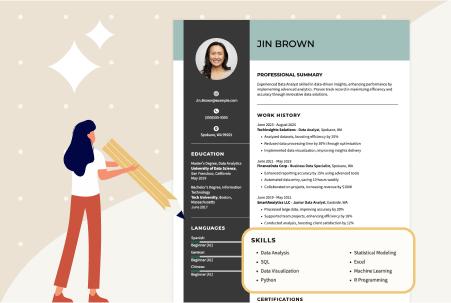
Essential Data Analyst Skills for Your Resume
Data analyst work is fundamental to organizational success, encompassing diverse responsibilities crucial for data-driven decision-making and operational efficiency. Data analysts play a pivotal role in interpreting data trends, optimizing processes,

Gen Z Job Market Trends: Data Reveals College Graduate Unemployment Rate Is on the Rise
A college degree has long been seen as the ticket to better pay, career stability, and increased employment opportunities. But for today’s graduates, that promise is slipping away. Research from the
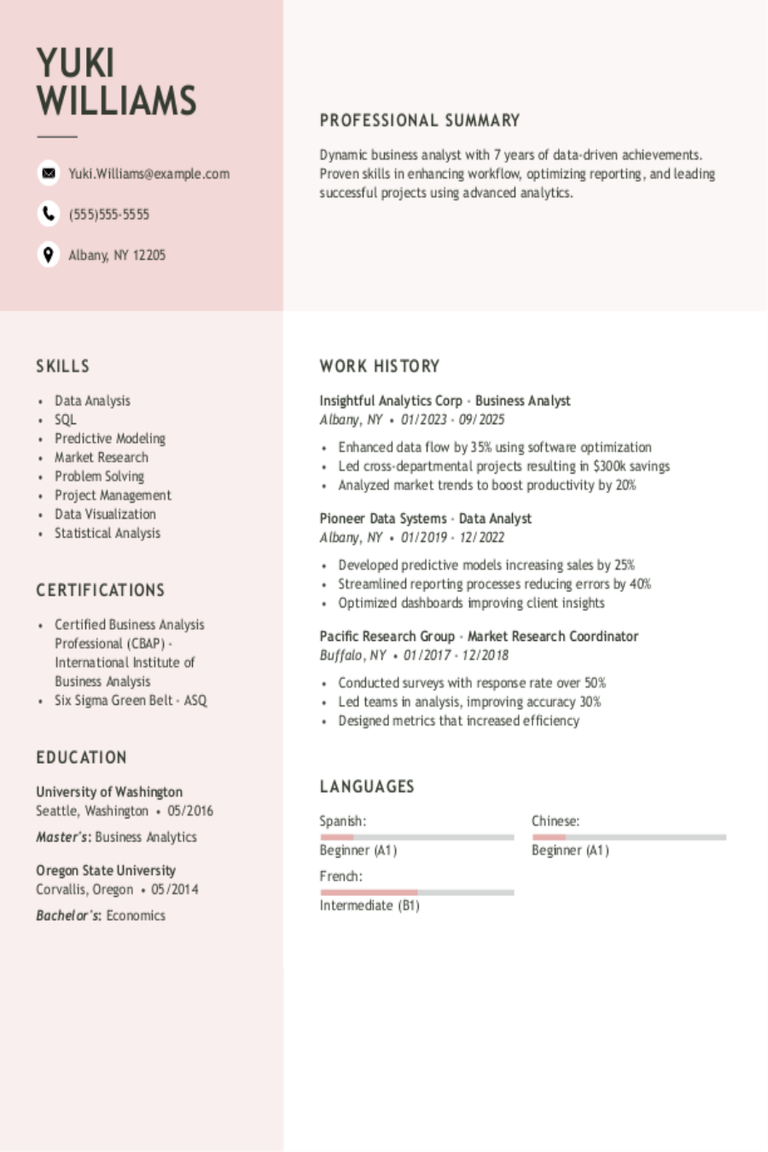
Business Analyst Resume Examples & Templates for 2025
Explore business analyst resume examples to see how to showcase your problem-solving, teamwork, and data skills. Browse tips to highlight your experience turning ideas into action and improving processes to
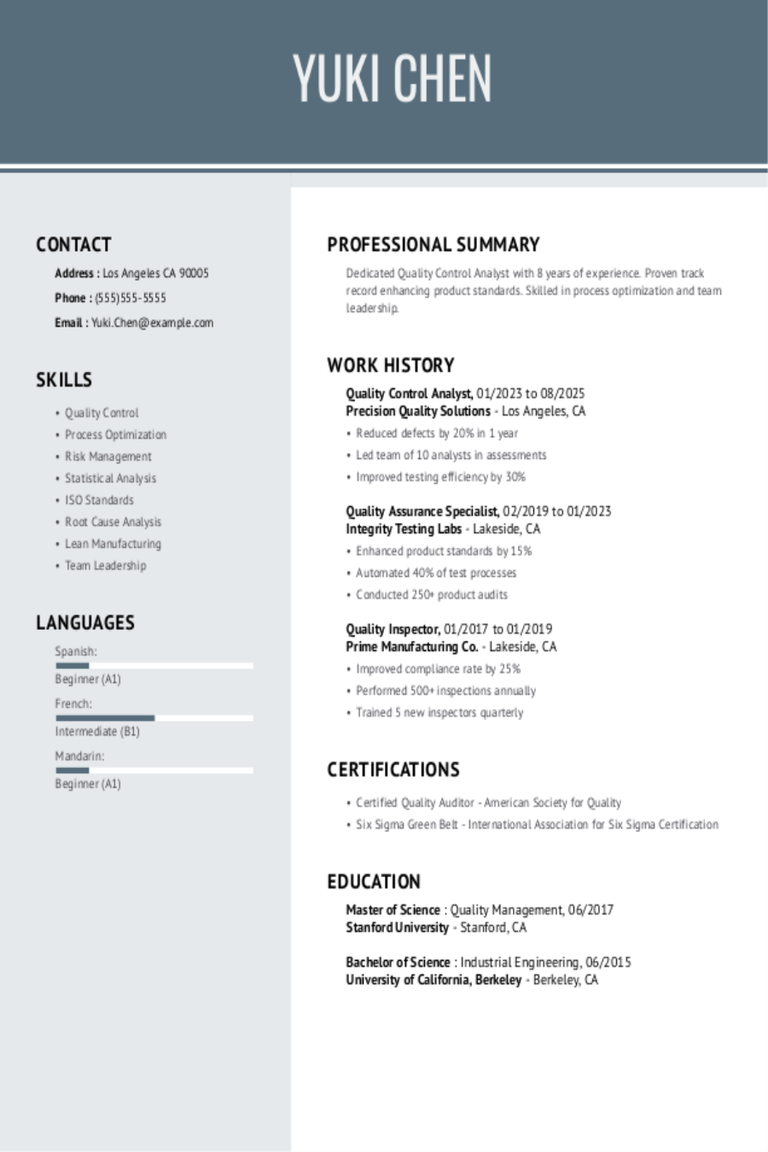
Quality Control Analyst Resume Examples & Templates for 2025
Discover how quality control analysts showcase their skills in monitoring products and ensuring standards are met. These resume examples will help you highlight your experience with testing processes and improving
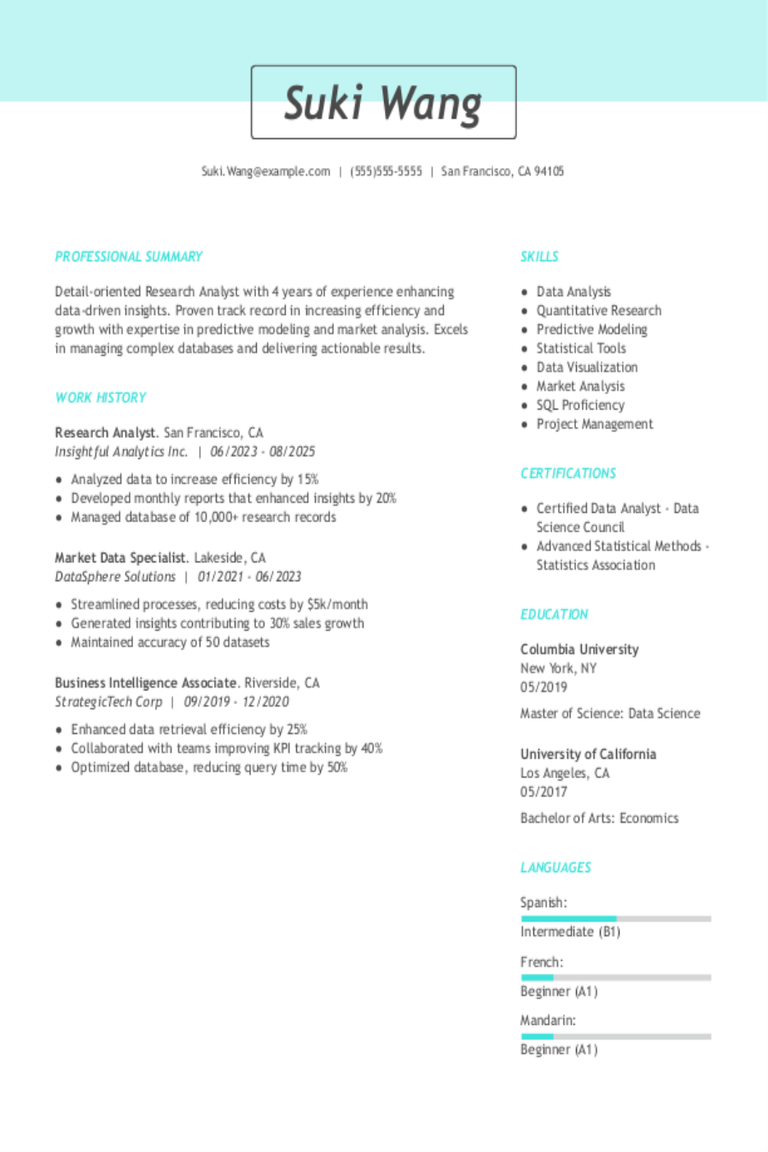
Research Analyst Resume Examples & Templates for 2025
Browse research analyst resume examples and learn how to spotlight your skills in data analysis, problem-solving, and research techniques.Build my resumeImport existing resumeCustomize this templateWhy this resume worksQuantifies accomplishments: By
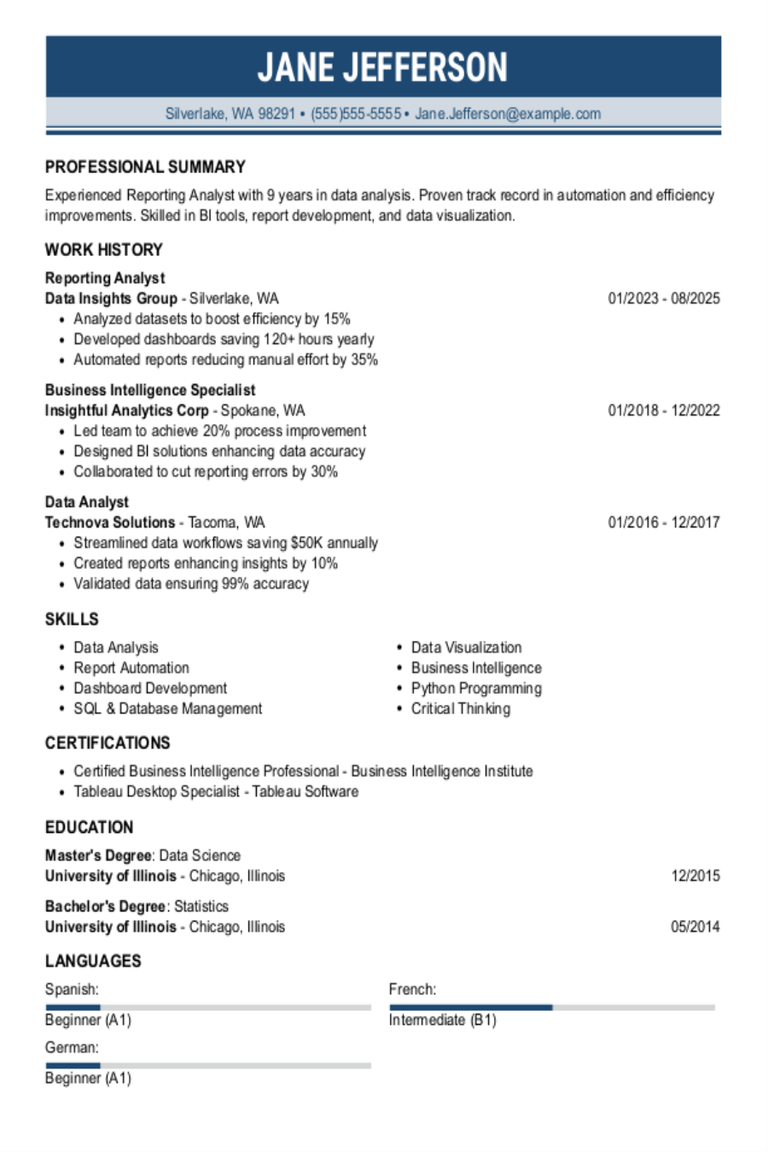
Reporting Analyst Resume Examples & Templates for 2025
Discover reporting analyst resume examples and learn to showcase your experience in creating reports and making insights stand out to potential employers.Build my resumeImport existing resumeCustomize this templateWhy this resume
